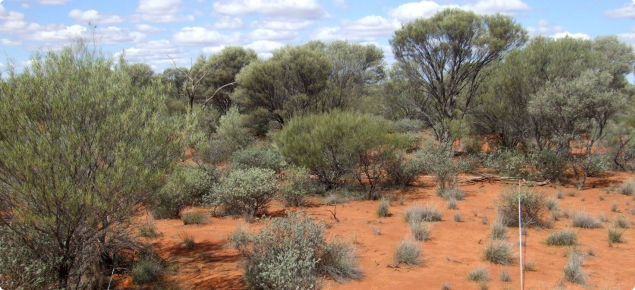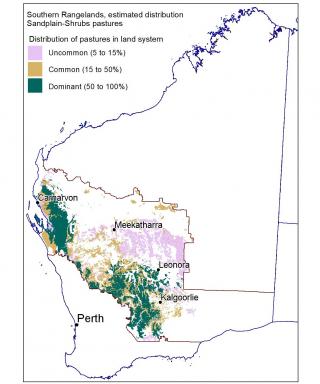Pastoral potential – low
The pastoral value of the sandplain acacia pastures is low. However, ‘Bowgada beans’ (pods of Acacia ramulosa) are very palatable and with a crude protein level of greater than 20% (Mitchell and Wilcox 1994), and can be a valuable feed resource for short periods.
Suggested levels of use (per annum)
Table 1 provides a rough guide to the range of pastoral values for good condition pastures, which must be checked against conditions in each region and paddock. Carrying capacities for fair condition pastures might be 75% to 50% of good, and poor condition pastures less than 50% of good.
See Introduction to pastures in the southern rangelands of Western Australia for an explanation of how carrying capacities are estimated.
| Condition | Carrying capacity ha/DSE1 | Carrying capacity ha/CU2 (ha/AE3) |
|---|---|---|
| Good | 20–29.9 | 140–209 (168–251) |
1 DSE is based on the feed energy required to maintain a 45 kilogram liveweight Merino wether with zero weight change, no wool growth additional to that included in maintenance, and walking 7 km/day. 1 DSE has an energy requirement of approximately 8.7 MJ ME/day.
2 CU in the southern rangelands is based on a 400 kg steer at maintenance and equivalent to 7 DSE.
3 AE is based on the feed energy to maintain a 450 kg Bos taurus steer 2.25 years of age, walking 7 kilometers each day. 1 AE has an energy requirement of approximately 73 MJ ME/day and equivalent to 8.4 DSE.
Managing sandplain acacia pastures in the southern rangelands
Heavy grazing of sandplain acacia pastures can eliminate the few palatable perennial shrubs that might be present. A mix of burnt and unburnt areas in combination are useful for stock. Unburnt areas provide shelter, palatable Bowgada beans and wanderrie grass in favourable seasons. Recently burnt areas can provide a wide range of palatable low shrubs and annuals in season during the re-colonisation period.
Intense fires have eliminated bowgada from some areas. Hot fires can eliminate the acacia overstorey, allowing recruitment of some understorey species, like cotton bush. The initial post-fire colonisers are replaced, and there is a slow recruitment of longer-lived acacias with the climax acacia-dominated community re-establishing after about 30 years.
Grazing should be deferred for at least one growing season immediately following fire to allow low shrubs to establish and herbs to set seed. The tall acacia scrub is normally too dense for sufficient grass growth to carry fire. Extended dry periods can kill and open up the overstorey, or exceptional summer rainfall events sufficient grassy understoreys can permit a sufficient grass fuel load to grow. When fires occur, the thick scrub can support large and extensive fires. Major fires were recorded in 1964 and 2011 in the Carnarvon region. Extended dry periods and fire frequency are likely to increase with forecast climate change.
Pasture condition
Survey and rangeland condition assessment data show that sandplain acacia pastures in the southern rangelands are predominantly in fair condition. These pastures are usually very stable and erosion is rare.
Good (unburnt)
See Figure 1. The tall shrub overstorey can be quite dense, limiting the development of the understorey. Palatable low shrubs and the occasional grasses are often quite scattered and sparse. Palatable low shrubs such as warty-leaf eremophila, bluebushes, ruby saltbush, green cassia and tall saltbush occur beneath the taller shrubs. Unpalatable sandbank poverty bush, pebble bush and tomato bush are occasionally present. The soil surface is usually soft and friable. There is no erosion.
In burnt pastures the overstorey is reduced and the range of low shrubs increases. Cotton bush and crinkle leaf cassia are common and co-dominate the low shrub component with flat leaf bluebush, Wilcox bush, tall saltbush and cottony saltbush.
Fair (unburnt)
See Figure 2. The range of species remains broad but fewer palatables are present. It may be easier to see through the vegetation and browse lines may develop. Density of unpalatables such as sandbank poverty bush, pebble bush and tomato bush may increase marginally. Erosion is rare.
The density and vigour of desirable indicators will decline 10 to 15 years after fire. The low shrubs such as cotton bush and flannel bush tend to increase as more palatable species are grazed out and undesirables may increase.
Poor (unburnt)
See Figure 3. Species diversity is much reduced and few palatables remain. Browse lines enable visibility through the shrubland. Surviving palatables often show evidence of heavy grazing or are small and hidden amongst other shrubs. Unpalatables may continue to increase but are not usually weedy. The ground may have a swept appearance due to sheetflow washing leaf litter away. Erosion is rare.
Previously burnt areas
These support a very reduced range of species. There are few, if any, desirable indicators and those remaining lack vigour. Cotton bush and flannel bush are increasingly grazed as the more palatable species are eaten out. Unpalatable poverty bushes, cassias and tomato bush may dominate the pasture. Wind erosion is more common in recently burnt areas as the soil surface is unprotected.
Sandplain acacia pastures condition photographs
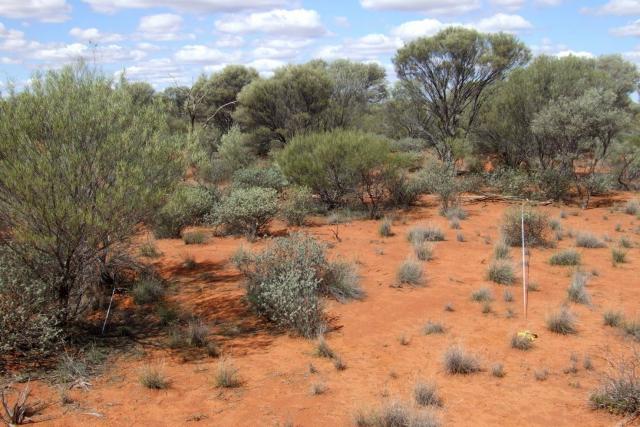
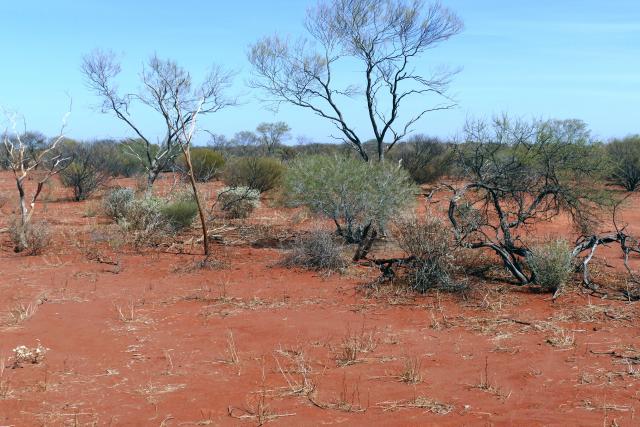
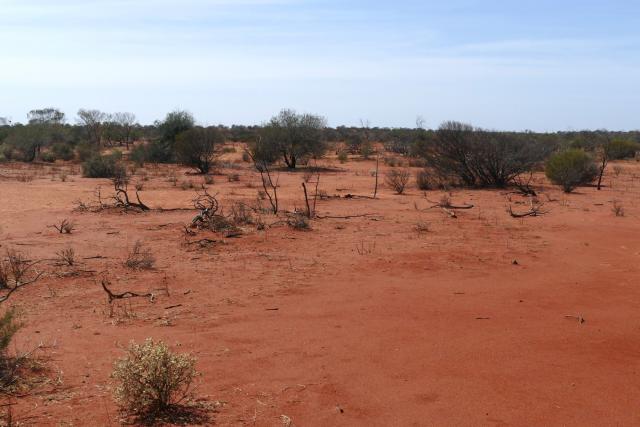
Figure 71 shows a sandplain acacia community in poor condition. Desirable low shrubs have been grazed out, and the bush clumps are breaking down. There are serious hydrological problems. The site is an undulating plain in the Yaringa land system.
Vegetation structure and composition
Vegetation is dominated by Bowgada and sugar brother. Trees are scattered and may include mulga, native pine or several species of eucalypts. Other prominent tall shrubs can include curara, limestone wattle and sandplain wattle. Low shrubs are sparse and struggle to grow beneath the tall shrubs. The shrub layer may include Wilcox bush, turkey bush, turpentine bush, rhagodias, variable cassia, crinkle leaf cassia, green cassia, cotton bush and other species.
Common palatable species include cotton bush, horse mulla mulla, warty-leaf eremophila, green cassia and silky bluebush. Wilcox bush is quite palatable on granite soils, it is less palatable in these pastures and should not be relied upon as an indicator of condition. Unpalatable low shrubs include poverty bushes such as sandbank poverty bush and turkey bush.
These pastures support similar perennial grasses to wanderrie grass pastures, normally in much lower numbers, although soft and broad leaf wanderrie grasses may be plentiful following wet years, particularly with summer rains. These include broad leaf wanderrie grass, soft wanderrie grass and buck wanderrie grass. Greybeard grasses and feather speargrass become more common in the south and east of the southern rangelands. Buffel and birdwood grasses and spinifex are of local importance. If spinifex is abundant and extensive in area, these pastures are called hard spinifex pastures.
Annual grasses such as wind grass, three-awned wanderrie grass and forbs occupy inter-tussock spaces in favourable seasons. These annuals may become dominant under continuous heavy grazing.
Occurrence
Sandplain acacia pastures occur throughout the southern rangelands, covering an estimate 9.49 million hectares (11.7% of the southern rangelands). These pastures typically occur on sandy banks, sand sheets and sandplains in a variety of land systems with sandy soils which typically consist of non-calcareous, deep, red or yellow sands, with acid or neutral soil reaction trends through their profiles.
Associated plants
| Common Name | Scientific name (links to FloraBase) | Desirability* |
|---|---|---|
| Birdwood grass | D | |
| Broad leaf wanderrie grass | D | |
| Buffel grass | D | |
| Cotton bush | D | |
| Feather speargrass | D | |
| Felty leaf bluebush | D | |
| Golden bluebush, George's bluebush | D | |
| Green cassia | D | |
| Horse mulla mulla | D | |
| Rhagodias | Rhagodia spp. | D |
| Roebourne plains grass | D | |
| Ruby saltbush | D | |
| Silky bluebush | D | |
| Soft wanderrie grass | D | |
| Split leaf buttercup bush | D | |
| Warty-leaf eremophila | D | |
| Grey cassia, desert cassia | U | |
| Crinkle leaf cassia | U | |
| Pebble bush | U | |
| Sandbank poverty bush | U | |
| Shark Bay poverty bush | U | |
| Straight leaf cassia, variable cassia | U | |
| Tomato bush | U | |
| Turkey bush | U | |
| Turpentine bush | U | |
| Bowgada, wanyu, horse mulga | I | |
| Buck wanderrie grass | I | |
| Cottony saltbush | I | |
| Curara | I | |
| Flannel bush | I | |
| Greybeard grasses | Amphipogon spp. | I |
| Limestone wattle | I | |
| Mulga | I | |
| Sandplain wattle | I | |
| Sugar brother | I | |
| Thin-leaved poverty bush | I | |
| Witchetty bush, granite wattle | I | |
| Woollybutt grass | I | |
| Creeping wanderrie grass | N | |
| Native poplar | N | |
| Firebush | N | |
| Gums, eucalypts | Eucalyptus spp. | N |
| Native pine | Callitris spp. | N |
| Spinifex | Triodia spp. | N |
| Wilcox bush | N | |
| Three-awned wanderrie grass | annual | |
| Wind grass | annual |
* D = desirable, U = undesirable, I = intermediate, N = no indicator value
Other resources
- Mitchell, AA and Wilcox, DG (1994) Arid shrubland plants of Western Australia, 2nd edn, University of WA Press, Nedlands.

